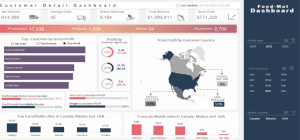
Introduction:
In the rapidly evolving landscape of e-commerce, businesses are faced with an abundance of data that holds the potential to unlock valuable insights. Data analysis in e-commerce has become a critical component for businesses looking to thrive in a competitive marketplace. By effectively harnessing and analyzing data, businesses can uncover hidden patterns, trends, and correlations that can drive strategic decision-making, enhance operational efficiency, and fuel business growth.
Section 1: The Power of Data in E-commerce
The e-commerce industry generates vast amounts of data through various channels such as online sales, customer interactions, website analytics, and social media engagement. This data encompasses a wide range of information, including customer demographics, purchase history, browsing behavior, and feedback. Recognizing the value of this data and harnessing its potential is crucial for e-commerce businesses to gain a competitive edge.
Section 2: Key Data Analysis Techniques
Data analysis techniques play a vital role in transforming raw data into actionable insights. In this section, we explore some key data analysis techniques commonly used in e-commerce:
- Descriptive Analysis: Descriptive analysis involves summarizing and visualizing data to gain a comprehensive overview of key metrics, such as sales performance, customer segmentation, and product trends. It provides businesses with a snapshot of their e-commerce operations and helps identify areas for improvement.
- Customer Segmentation: Customer segmentation allows businesses to categorize their customers based on various attributes, such as demographics, purchase history, and behavior. By understanding the distinct needs and preferences of different customer segments, businesses can tailor their marketing strategies, personalize customer experiences, and optimize product offerings.
- Predictive Analytics: Predictive analytics utilizes statistical models and machine learning algorithms to forecast future outcomes based on historical data. In e-commerce, predictive analytics can be applied to predict customer behavior, optimize inventory management, and identify potential opportunities for cross-selling and upselling.
- Sentiment Analysis: Sentiment analysis involves extracting and analyzing customer sentiments from sources such as customer reviews, social media mentions, and customer support interactions. By understanding customer sentiment, businesses can identify areas for improvement, address customer concerns, and enhance overall customer satisfaction.
Section 3: Driving Business Growth with Data Insights
Effective data analysis in e-commerce can lead to numerous benefits and drive business growth. This section explores how businesses can leverage data insights to fuel growth:
- Personalized Marketing: By analyzing customer data, businesses can personalize marketing campaigns and tailor promotional offers to individual customer preferences. This targeted approach increases the likelihood of customer engagement and conversions.
- Inventory Optimization: Data analysis enables businesses to optimize inventory management by forecasting demand, identifying slow-moving products, and minimizing stockouts. This ensures that the right products are available at the right time, improving customer satisfaction and reducing costs.
- Conversion Rate Optimization: Data analysis can uncover insights into customer behavior on e-commerce websites, allowing businesses to optimize the user experience, streamline the purchase journey, and increase conversion rates. By identifying barriers to conversion, businesses can make data-driven improvements that enhance the overall shopping experience.
- Competitive Intelligence: Analyzing market data and competitor insights can provide valuable information on industry trends, customer preferences, and competitive strategies. This allows businesses to stay ahead of the competition and identify opportunities for differentiation and innovation.
Section 4: Overcoming Challenges and Ensuring Data Security
While data analysis offers immense potential, it also presents challenges that e-commerce businesses must address. This section discusses key challenges such as data quality, data privacy, and ensuring data security. It emphasizes the importance of implementing robust data governance practices and complying with data protection regulations to safeguard customer information.
Conclusion:
In the era of e-commerce, data analysis has emerged as a game-changer for businesses seeking growth and success. By harnessing the power of data and employing effective data analysis techniques, businesses can gain valuable insights, optimize operations, and make informed decisions. Data analysis in e-commerce is a powerful tool that empowers businesses to understand their customers, stay competitive, and unlock new opportunities for growth in the digital landscape.

